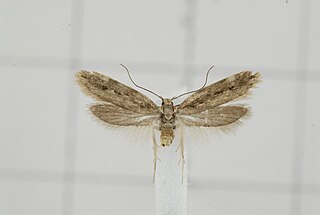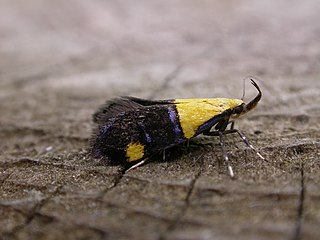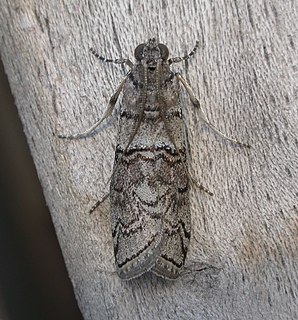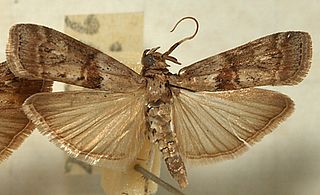| Potato moth | |
|---|---|
 | |
| Imago captured on the Hawaiian island of Maui | |
| Scientific classification | |
| Kingdom: | Animalia |
| Phylum: | Arthropoda |
| Class: | Insecta |
| Order: | Lepidoptera |
| Family: | Autostichidae |
| Genus: | Stoeberhinus Butler, 1881 |
| Species: | S. testaceus |
| Binomial name | |
| Stoeberhinus testaceus Butler, 1881 | |
| Synonyms | |
Numerous, see text | |
Stoeberhinus testaceus, the potato moth, is a gelechioid moth, supposedly the only species of its genus Stoeberhinus. However, the genus might also include some related moths presently placed in Autosticha . It belongs to the subfamily Autostichinae, which is either placed in the concealer moth family (Oecophoridae), or in an expanded Autostichidae. [1]
In biology, a species ( ) is the basic unit of classification and a taxonomic rank of an organism, as well as a unit of biodiversity. A species is often defined as the largest group of organisms in which any two individuals of the appropriate sexes or mating types can produce fertile offspring, typically by sexual reproduction. Other ways of defining species include their karyotype, DNA sequence, morphology, behaviour or ecological niche. In addition, paleontologists use the concept of the chronospecies since fossil reproduction cannot be examined. While these definitions may seem adequate, when looked at more closely they represent problematic species concepts. For example, the boundaries between closely related species become unclear with hybridisation, in a species complex of hundreds of similar microspecies, and in a ring species. Also, among organisms that reproduce only asexually, the concept of a reproductive species breaks down, and each clone is potentially a microspecies.
A genus is a taxonomic rank used in the biological classification of living and fossil organisms, as well as viruses, in biology. In the hierarchy of biological classification, genus comes above species and below family. In binomial nomenclature, the genus name forms the first part of the binomial species name for each species within the genus.

Autosticha is a genus of gelechioid moths. It belongs to the subfamily Autostichinae, which is either placed in the concealer moth family (Oecophoridae), or in an expanded Autostichidae. It is the type genus of its subfamily. Originally, this genus was named Automola, but this name properly refers to a fly genus in family Richardiidae.
Contents
It is a small moth with buff and brown-mottled (potato-colored) forewings. Like Autosticha, this moth has the second and third forewing vein emerging from a common stalk; unlike in that genus, the labial palps of S. testaceus males are beset with feathery hairs, while the labial palps of the females are inconspicuous and do not taper like those of both sexes of Autosticha. [2]

The potato is a starchy, tuberous crop from the perennial nightshade Solanum tuberosum. In many contexts, potato refers to the edible tuber, but it can also refer to the plant itself. Common or slang terms include tater, tattie and spud. Potatoes were introduced to Europe in the second half of the 16th century by the Spanish. Today they are a staple food in many parts of the world and an integral part of much of the world's food supply. As of 2014, potatoes were the world's fourth-largest food crop after maize (corn), wheat, and rice.
This moth is common and widespread in the warmer parts of the Pacific region. It was originally described by Arthur Gardiner Butler in 1881 from specimens collected at Honolulu, Hawaii. The species has since been recorded from Java [ verification needed ], the New Hebrides, Fiji, Samoa, the Cook Islands [ verification needed ], the Marquesas across the Society and Tuamotu Islands to the Austral Islands, as well as from the Galápagos Islands (though it might not breed there). Its origin is not well understood and it seems to be something of a "supertramp species". [2]

Arthur Gardiner Butler was an English entomologist, arachnologist and ornithologist. He worked at the British Museum working on the taxonomy of birds, insects, and spiders.

Honolulu is the capital and largest city of the U.S. state of Hawaiʻi. It is an unincorporated part of and the county seat of the City and County of Honolulu along the southeast coast of the island of Oʻahu. The city is the main gateway to Hawaiʻi and a major portal into the United States. The city is also a major hub for international business, military defense, as well as famously being host to a diverse variety of east-west and Pacific culture, cuisine, and traditions.

Java is an island of Indonesia, bordered by the Indian Ocean on the south and the Java Sea on the north. With a population of over 141 million or 145 million, Java is the home to 56.7 percent of the Indonesian population and is the world's most populous island. The Indonesian capital city, Jakarta, is located on its northwestern coast. Much of Indonesian history took place on Java. It was the center of powerful Hindu-Buddhist empires, the Islamic sultanates, and the core of the colonial Dutch East Indies. Java was also the center of the Indonesian struggle for independence during the 1930s and 1940s. Java dominates Indonesia politically, economically and culturally. Four of Indonesia's eight UNESCO world heritage sites are located in Java: Ujung Kulon National Park, Borobudur Temple, Prambanan Temple, and Sangiran Early Man Site.
The caterpillar larvae eat all sorts of dry leaves, in which they build silken tunnels. They have also been recorded on living plants of the looking-glass mangrove (Heritiera littoralis), though the significance of this is unknown. [2]

Caterpillars are the larval stage of members of the order Lepidoptera.
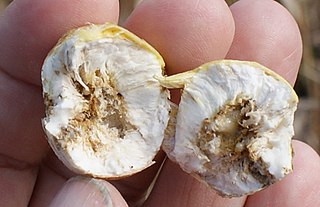
A larva is a distinct juvenile form many animals undergo before metamorphosis into adults. Animals with indirect development such as insects, amphibians, or cnidarians typically have a larval phase of their life cycle.

